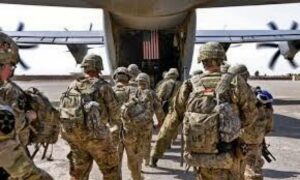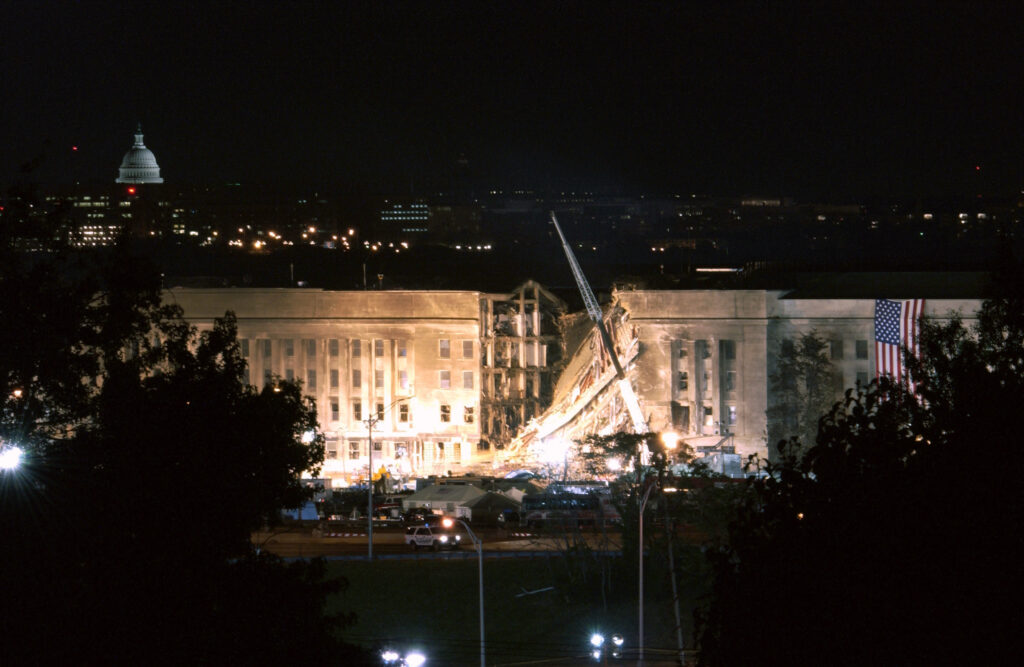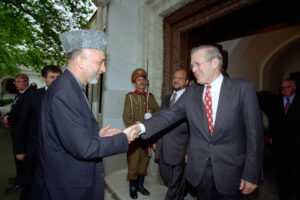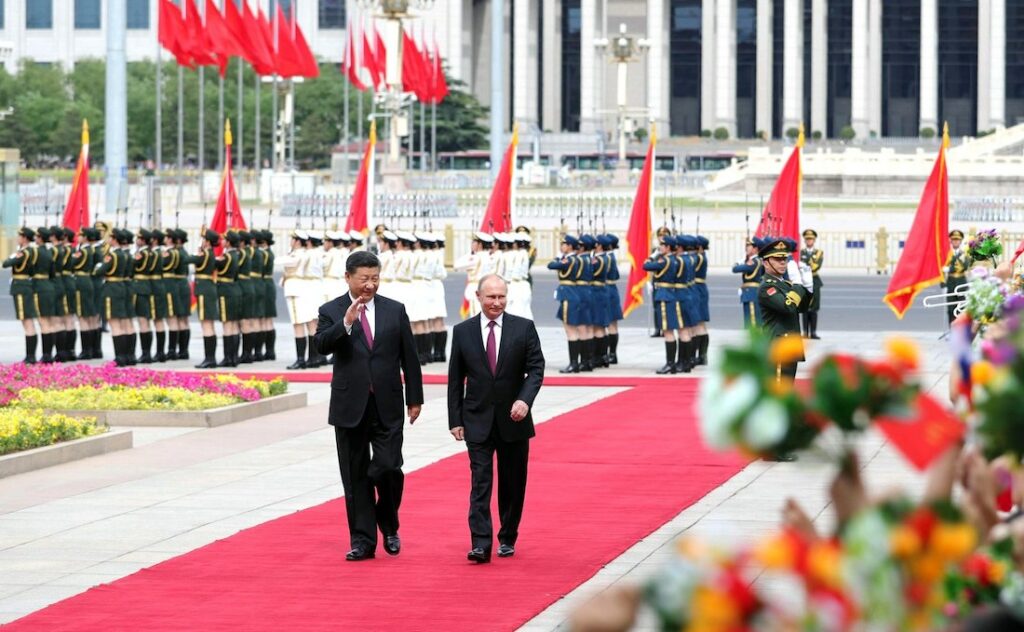 After nearly twenty years of war and occupation in Afghanistan, U.S. armed forces finally completed their withdrawal on August 31, leaving the country in the hands of the Taliban, the organization that it had removed from power when the U.S. originally invaded in October 2001. Just a few weeks earlier, President Joe Biden had told a press conference that there were no significant parallels between the U.S. withdrawal from Afghanistan and its final withdrawal from Vietnam in 1975. He added that “the likelihood there’s going to be the Taliban overrunning everything and owning the whole country is highly unlikely.”
After nearly twenty years of war and occupation in Afghanistan, U.S. armed forces finally completed their withdrawal on August 31, leaving the country in the hands of the Taliban, the organization that it had removed from power when the U.S. originally invaded in October 2001. Just a few weeks earlier, President Joe Biden had told a press conference that there were no significant parallels between the U.S. withdrawal from Afghanistan and its final withdrawal from Vietnam in 1975. He added that “the likelihood there’s going to be the Taliban overrunning everything and owning the whole country is highly unlikely.”But by the time the U.S. left, the Taliban was back in control. And the chaotic scenes at the Hamid Karzai International Airport in Kabul in the weeks leading up to the U.S. departure reminded many of the desperate panic at the U.S. embassy in Saigon forty-six years before.
Of course, there are also many differences between Vietnam and Afghanistan. Facile analogies should be avoided. But by any measure, this was an ignominious defeat for the world’s most powerful military nation, only days before the twentieth anniversary of the September 11 attacks.
When members of al Qaeda hijacked four planes and flew three of them into the Twin Towers of the World Trade Center in New York City and the Pentagon near Washington D.C. (the fourth crashed into a field in Pennsylvania after its passengers fought back), anti-war activists in the United States raised the slogan “Don’t Turn Tragedy into War.”
Some of us also pointed out that however unjustifiable the attacks, the U.S. government itself bore its own share of responsibility for them because of its long-term imperialist meddling in both the Middle East and Afghanistan.

In April 1978, the pro-Soviet People’s Democratic Party of Afghanistan (PDPA) came to power following a military coup. It attempted to rapidly introduce a series of social reforms, but while its cadre may have had the best of intentions, they had little support in the country at large. Its efforts produced a backlash, particularly in rural areas, which soon led to armed clashes.
The U.S. government, still stinging from its defeat in Vietnam, saw an opportunity. From the summer of 1979, it began secretly funneling support to government opponents. According to Jimmy Carter’s National Security Adviser, Zbigniew Brezinski:
…it was July 3, 1979, that President Carter signed the first directive for secret aid to the opponents of the pro-Soviet regime in Kabul. And that very day, I wrote a note to the president in which I explained to him that in my opinion this aid was going to induce a Soviet military intervention…. We didn’t push the Russians to intervene, but we knowingly increased the probability that they would.
With the country spiraling towards civil war and a power struggle breaking out between different factions of the PDPA, the Soviet Union sent in troops in December 1979 to prop up a friendly government on its border. That same day Brezinski sent Carter a letter: “We now have the opportunity of giving to the USSR its Vietnam War.”
In effect, that is what happened. The Soviet occupation lasted for over nine years. It was a brutal and bloody affair, which left over one million Afghans dead. But just like the U.S. in Vietnam, the Soviets were never able to defeat the rebels, who called themselves “mujahideen” or holy warriors, and who received billions of dollars of aid from Washington, first from Carter and then from Reagan.
The CIA also encouraged tens of thousands of Islamic radicals to come to Afghanistan to fight the Soviets. They received training and weapons from the Pakistani security services, paid for by U.S. taxpayers.
The U.S. knew it was backing reactionary forces, but it was willing to do so to win the Cold War. And it worked. The occupation was a huge financial burden for Moscow, which finally withdrew in February 1989. Most commentators think that the impact of the war played a significant role in the collapse of the Soviet government two years later.
U.S. officials broke out the champagne when Soviet troops left Afghanistan, but they left behind a country in virtual anarchy, with rival factions of the mujahideen fighting amongst themselves and a Soviet-installed president, Muhammed Najibullah, under siege in Kabul. The city finally fell to one mujahideen group in 1992. Najibullah was executed but the civil war continued until 1996 when the Taliban, a new force with its own highly rigid interpretation of Islam, took over an exhausted country with support from Pakistan.
The U.S. had won the Cold War, but it had also created a huge network of Islamic radicals trained in guerrilla tactics. One of the first non-Afghan volunteers to join the ranks of the mujahideen was Osama bin Laden, a civil engineer and businessman from a wealthy construction family in Saudi Arabia, with close ties to members of the Saudi royal family.
Bin Laden recruited 4,000 volunteers from his own country and developed close relations with the most radical mujahideen leaders. He also worked closely with the CIA, raising money from private Saudi citizens.
According to the Indian journalist Rahul Bhedi, “In 1988, with U.S. knowledge, bin Laden created Al-Qaeda (The Base): a conglomerate of quasi-independent Islamic terrorist cells spread across at least 26 countries. Washington turned a blind eye to Al-Qaeda, confident that it would not directly impinge on the U.S.” Instead, during the 1990s, the network that the U.S. had helped create was linked to terrorist attacks in the Philippines, Pakistan, Saudi Arabia, France, Tajikistan, Azerbaijan, China, Egypt, Algeria, and Morocco, as well as on U.S. targets.
“This is an insane instance of the chickens coming home to roost,” one U.S. diplomat in Pakistan told the Los Angeles Times. “You can’t plug billions of dollars into an anti-Communist jihad, accept participation from all over the world and ignore the consequences. But we did.”
The CIA had its own name for this phenomenon: blowback.

Democratic Republic of Afghanistan President Hamid Karzai (left), shakes hands and greets U.S. Secretary of Defense Donald H. Rumsfeld, as he arrives at the Presidential Palace in Kabul, Afghanistan on May 1, 2003. (DOD Photo by Helene C. Stikkel) (Released)
For the family members of the victims, the 9/11 attacks were a tragedy, but for the Bush administration and the U.S. ruling class, they were a golden opportunity.
Bush had come into office with the goal of reasserting U.S. power in the Middle East, starting with regime change in Iraq. In his book The Price of Loyalty, Bush’s first Treasury Secretary, Paul O’Neill, later revealed that discussions about invading Iraq began taking place in cabinet meetings in February 2001. What was needed was a pretext to do so.
According to insider reports from Richard Clarke, the administration’s “counter-terrorism czar”, and Washington Post journalist Bob Woodward, within hours of the attacks on the Twin Towers and the Pentagon, Bush, Vice President Dick Cheney, and Secretary of Defense Donald Rumsfeld were trying to use them as an excuse to overthrow the government of Saddam Hussein.
They were soon persuaded, however, that Iraq was a bridge too far. What they could get away with immediately was building an international coalition to invade Afghanistan. The plan was that this could then serve as a stepping-stone for a later attack on Iraq.
Of course, the public justification for the war was that the Taliban government was harboring Osama bin Laden, the alleged “mastermind” of the September 11 attacks. But the Bush administration was never serious about capturing bin Laden, who was much more useful as a bogeyman.
Soon after the attacks, Taliban government officials announced that they would extradite bin Laden to stand trial if, in accordance with international law, the U.S. government would provide evidence of his involvement. Secretary of State Colin Powell promised to issue a dossier documenting bin Laden’s role, but the dossier never appeared.
In late September and early October, political leaders in Pakistan proposed extraditing bin Laden to their country, where he could be tried by an international tribunal, but this plan was dismissed by the U.S. government.
The Australian journalist John Pilger quoted the response of one U.S. official: “casting our objectives too narrowly” risked “a premature collapse of the international effort if by some lucky chance Mr. bin Laden was captured.” In other words, the U.S. was not interested in bin Laden or other al Qaeda leaders being handed over, because this would remove the rationale to invade Afghanistan, which the Bush administration was hell-bent on doing.
The claim made by Bush, and later repeated by Obama, that the U.S. had no choice but to invade Afghanistan was a transparent lie.
The initial invasion was a one-sided rout. The Taliban was quickly swept aside, and the U.S. and its allies began the process of trying to construct a stable government that would be beholden to U.S. interests.
Almost as soon as the first phase of the war was over, the Bush administration began turning its attention to Iraq, first by making utterly implausible claims that Iraq’s President Saddam Hussein was in league with al Qaeda, then by spreading the lie that Iraq was in possession of weapons of mass destruction and claiming that this justified a preemptive attack.
Why the almost fanatical focus on Iraq? The most obvious answer was oil. “Regardless of whether we say so publicly,” said Anthony H. Cordesman, then as now an analyst at Washington’s Center for Strategic and International Studies, “we will go to war, because Saddam sits at the center of a region with more than 60 percent of all the world’s oil reserves.”
Shortly after taking office, the Bush administration commissioned a study from the Baker Institute for Public Policy at Houston’s Rice University—a think-tank run by James Baker III, Secretary of State for Bush senior, with an array of advisers from major energy and oil companies. The report, Strategic Energy Policy Challenges For the 21st Century, was issued in April 2001. It warned that the U.S. faced “unprecedented energy price volatility” and concluded:
The United States remains a prisoner of its energy dilemma. Iraq remains a destabilizing influence … to the flow of oil to international markets from the Middle East. Saddam Hussein has also demonstrated a willingness to threaten to use the oil weapon and to use his own export program to manipulate oil markets. Therefore the U.S. should conduct an immediate policy review toward Iraq including military, energy, economic and political/diplomatic assessments.
This was followed in May, with an energy report from the office of Vice President Cheney, which stated that the U.S. was increasingly dependent on imported oil and that it might be necessary to overcome foreign resistance to gain access to new supplies. The political scientist Michael Klare summed up the administration’s position as follows:
American efforts to obtain increased supplies of foreign oil will require more than trade deals and diplomacy—it will also require the threat of or the use of force to dissuade hostile forces from attempting to obstruct the flow of petroleum to the United States. This, in turn, will require an enhanced U.S. capacity to operate militarily in areas of likely fighting over oil…. And while these efforts have been accelerated since September 11, it is important to note that they began well before that date.
While an invasion of Iraq would certainly disrupt production and cause a sharp spike in the price of oil, the Bush administration bet that this would be a temporary phenomenon. With a U.S.-puppet regime installed in Baghdad, the hope was that within a few years there would be an abundant supply of cheap oil on the world market. According to Lawrence Lindsey, Bush’s former economic adviser, “When there is a regime change in Iraq, you could add three to five million barrels [per day] of production to world supply. The successful prosecution of the war would be good for the economy.”
Donald Kagan, a member of the neo-conservative Project for the New American Century (PNAC), a think tank with close ties to the Bush administration, put it even more bluntly: “When we have economic problems, it’s been caused by disruptions in our oil supply. If we have a force in Iraq, there will be no disruption in oil supplies.”
But it was not mainly a question of securing oil for the U.S. itself. Europe, Japan and China were far more dependent on Middle Eastern oil than the U.S. A military occupation of Iraq would thus intended to give Washington increased leverage over its main economic rivals. Moreover, U.S. control of Iraqi oil would undermine the power of the OPEC cartel, which had long been a goal of U.S. foreign policy.
But oil was only part of the picture. After the collapse of the USSR in 1991, the U.S. had been left as the world’s only superpower. Maintaining this dominant position and preventing the emergence of a new global rival—in particular, China—now became a central goal of the U.S. foreign policy establishment, with Washington willing to use its military strength to ensure that it remained the dominant global power for the indefinite future.
The strategy was laid out in a document written by the PNAC in September 2000, which called for “maintaining global US pre-eminence … and shaping the international security order in line with American principles and interests.” This would include using overwhelming military force to take control of the Gulf region, with its strategically vital oil resources.
But the report also noted that to implement such aggressive policies, “some catastrophic and catalyzing event—like a new Pearl Harbor” would be needed. From that perspective the 9/11 attacks offered the Bush administration a golden opportunity to put into effect plans that it already wanted to pursue.
Afghanistan, as noted, was seen as a stepping-stone to Iraq and the Gulf, but it was also important for other strategic reasons. The Marxist political analyst Gilbert Achcar noted at the time:
[T]he ideological framework created by 9/11 and the Afghanistan war provided an opportunity to establish a direct military presence not only in Afghanistan but in Central Asia, which, strategically speaking, is considerably more important. Countries like Kyrgyzstan and Uzbekistan, where the United States set up air bases after 9/11, lie in the heart of the former Soviet Union. If you add to this the U.S. involvement in the Caucasus, you see that Washington is trying to set a military vise around the Caspian Basin, which is an important source of hydrocarbons, not only oil but especially gas.
Washington also hoped that a U.S. military presence at “the heart of the landmass extending from European Russia to China” would serve to keep both these rivals in check.
If these were the United States’ goals, it has failed to achieve them quite spectacularly. Far from keeping Russia and China in check, the wars in Afghanistan and Iraq trapped the U.S. in a quagmire. At the end of two decades, Russia and especially China have not been weakened, but have emerged as more powerful military and economic competitors.
Meanwhile, the two occupied countries, along with other parts of the Middle East, have been devastated by U.S. intervention. A recent report from the Costs of War Project at Brown University estimated that between 897,000 and 929,000 people have been killed as a result of the U.S. “War on Terror.” Of these, the vast majority were from Afghanistan or Iraq, and at least 387,000 were civilians, the majority women and children. Other estimates put the numbers even higher.
The total cost of these wars has been over $8 trillion—a vast expenditure for a series of imperialist adventures that from the U.S. government’s own point of view have left it weaker, not stronger.

The occupation of Afghanistan was characterized by twenty years of “chaos, corruption, and violence,” in the words of Ali M. Latifi, a freelance journalist based in the country. By early 2002, the Taliban had been virtually destroyed, but U.S. indifference to Afghani lives allowed it to gradually make a comeback.
Biden’s decision to withdraw troops was based on the calculation that the occupation was no longer serving U.S. imperial interests. There was also a miscalculation that the U.S.-backed government in Kabul would be able to hold out at least until the U.S. had left. The fact that the government of Ashraf Ghani and the Afghan military collapsed like a house of cards was final proof of the folly of the whole enterprise.
In a speech at the end of August, Biden claimed that the U.S. government had learned the lessons of Afghanistan. In reality, it has learned nothing. The withdrawal from Afghanistan represents not the end of U.S. imperialism, but simply a new phase, in which the administration intends to prioritize great power competition with Russia and China.
Obama attempted but failed to make a “pivot to Asia” during his second term. Biden hopes that disentangling from Afghanistan will allow him to succeed where Obama did not. Whether or not he can complete the shift remains an open question.
Following the suicide bombings outside the Kabul airport in the final days of the withdrawal, the New York Times reported that history had “got in the way” of U.S. attempts to extricate itself from Afghanistan.
American officials are reworking plans to counter threats that could emerge from Afghanistan’s chaos, according to current and former officials: negotiating for new bases in Central Asian countries; determining how clandestine officers can run sources in the country without the military and diplomatic outposts that provided cover to spies for two decades; and figuring out from where the C.I.A. could launch drone strikes and other Afghanistan operations.
For the rest of us, neither scenario—continued U.S. covert involvement in Afghanistan or a successful “pivot to Asia”—is anything to cheer about. The latter would simply increase the chances of military confrontation between the U.S. and China, while making the kind of global cooperation needed to address the climate crisis less likely.
In the early 1990s, following the collapse of the Soviet Union, the United States was at the peak of its power. It could have used the immense wealth and resources at its disposal to improve the lives of people around the world and to address major international problems. But that would have required not just better leaders, but the creation of an economic system in which human need and environmental sustainability, not the endless pursuit of profit, are the primary goals.
Imperialist wars in the Middle East and elsewhere, blowback like the 9/11 attacks, the new cold war with China, and the death spiral towards climate catastrophe, are the rotten fruits of capitalism. If we want to end them, we will have to replace the system that is their underlying cause.
First published by Tempest.


Leave a Reply